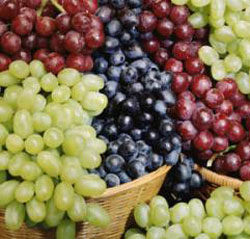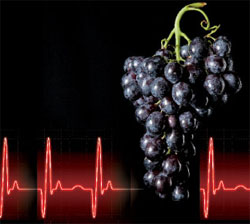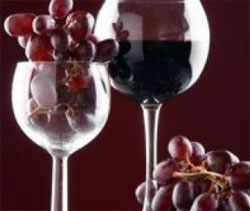Grapes – the divine fruit
By Crenguţa Roșu
Autumn has come, cover my … body with grapes and scent of dry leaves … the poet would say
 Grapes have been known for thousands of years as the fruit of the gods because of their exceptional nutritional and curative qualities that have surprised us until today. Called natural multi-vitamins by scientists, grapes are one of the most complete foods.
Grapes have been known for thousands of years as the fruit of the gods because of their exceptional nutritional and curative qualities that have surprised us until today. Called natural multi-vitamins by scientists, grapes are one of the most complete foods.
A plant with a long history
For thousands of years the grape-vine and its fruit symbolize harvest, abundant life, health and luck. The first vineyard owner of humanity is considered to be Noah, the famous biblical character who cultivated grape-vines after the flood.
In the mythology of many cultures grapes are a symbol of immortality. In the Romanian traditions the grape-vine is regarded as having a sacred character, some Romanian legends link the origin of the wine to the blood which flowed from the wounds of Christ. The sacredness of the grape-vine and of the wine itself has been acknowledged since before Christianity, based on how the wine was regarded by the Dacians, and according to some beliefs of the Romanians in Moldova. It is said that if you want to arrive at the gates of heaven, you have to work the grape-vine for seven years without complaining, or uttering insulting words, irrespective of the sacrifices, for that way God forgives your sins.
In ancient Israel, the grape-vine was also considered a sacred plant, being identified in ancient mythical traditions with the tree of life. The symbol of abundance and joy, it was likened in Christian tradition with the human soul which awakes and when, like the grape-vine, is worked on with dedication and care, is able to provide many fruits: the sweet grapes of the spiritual growth and of the proximity of God.
Gospel texts turn the grape-vine into a symbol of the Kingdom of Heaven; Jesus said that He is the true vine. Clement of Alexandria (150-220), the founder of the theology school of Alexandria said: “I allegorically see the vine as our Lord that we should feed ourselves with, but after a cultivation work done by the means of reason”. A plant that has inspired art and literature so much, which provided so many symbols and served as the basis of many allegories, it is loaded with special meanings not just in terms of regeneration, fortifying and strengthening of the soul, but also the whole being.
Health benefits
White, ruby or black, the sweet grape berries are full of pure water, close to the composition of the best mineral waters. In the grape juice there are dissolved trace elements that help the metabolism (molybdenum, titanium, rubidium, cobalt, nickel, vanadium, iodine), others that strengthen the walls of the blood vessels and heart muscle (potassium, magnesium) and iron is present in large quantities which helps prevent or treat anemia. Grapes also contain vitamins A, B1, B2, B6, PP, C, fatty acids (malic, tartaric, succinic), tannins, resin material and many sugars. The energy value of 100g of grapes is 98kcal, out of which 90% is assimilated in the body. Medical studies confirm that black grape is one of the healthiest fruits. It contains resveratrol – one of the most powerful natural antioxidants known; pycnogenol – the second most exogenous antioxidant, lycopene, lutein, bioflavonoids, omega 3 and 6 fatty acids, manganese, copper, antocianide, ellagic acid and melatonin.
Here is what the phytochemical compounds in grapes offer:
 Resveratrol, the star antioxidant, gives the black grapes an excellent antioxidant protection, reducing the total blood cholesterol levels, may have cytostatic activity in breast cancer, prevents and effectively combats osteoporosis. Scientific studies have shown that resveratrol reduces beta-amyloid peptides responsible for degeneration of brain tissue, so eating black grapes is effective in preventing Alzheimer’s disease and in slowing its progress for those who already have the disease.
Resveratrol, the star antioxidant, gives the black grapes an excellent antioxidant protection, reducing the total blood cholesterol levels, may have cytostatic activity in breast cancer, prevents and effectively combats osteoporosis. Scientific studies have shown that resveratrol reduces beta-amyloid peptides responsible for degeneration of brain tissue, so eating black grapes is effective in preventing Alzheimer’s disease and in slowing its progress for those who already have the disease.
Pycnogenol, the second antioxidant in force, present in black grapes, along with vitamins A, C and E have been studied in relation to cardiovascular degenerative diseases, in capillary fragility and peripheral venous insufficiency. Pycnogenol prevents and combats retinopathy (retinal disease).
Lycopene, the stunning red dye is a substance with antitumor effects in prostate, breast, bladder, pancreas, lungs and skin, cervical, ovarian, uterine, intestinal cancer. Lycopene reduces the risk of atherosclerosis and the incidence of the myocardial infarction decreases by 20-50% in people who often eat grapes, where the processes of cellular aging is slowed down. There are great hopes in the consumption of lycopene for the prevention of neoplazic, degenerative diseases.
Lutein, has a powerful antioxodant effect manifested not only in the visual apparatus, but also in other organs and in the metabolic chains, being able to be used with good results by all those who were recommended to increase the intake of antioxidants, for preventing cardiovascular disease, prostate cancer, etc. The effect of lutein is magnified by lycopene, with serious consequences in lowering blood cholesterol and slowing down or stopping the macular degeneration (a disease that includes a variety of eye diseases characterized by impaired central vision).
Bioflavonoids (quercetin, rutin, hesperidin, etc.) have a synergistic effect with vitamin C, having great importance in strengthening capillary walls. They strengthen capillaries, adjusting their permeability and they oppose the formation of varicose veins and hemorrhoids. Bioflavonoids also have an excellent antianginal, antiatherosclerotic and antithrombotic and cardiac tonic effect. Bioflavonoids prevent wrinkling and skin aging, maintaining its elasticity and youthfulness.
Omega-3 fatty acids regulate the menstrual cycle, reduce the frequency and intensity of menstrual pain and omega 6 fatty acids ensure proper functioning of the central nervous system.
Manganese is necessary for normal bone structure and joint cartilage; it is anti allergic and a powerful desensitizer.
 Copper contributes to the integrity of cell membranes, limits the formation of free radicals, strengthens the immune defense, reduces arthritis symptoms, and maintains the blood vessels in being clean (of atherosclerosis) and elastic.
Copper contributes to the integrity of cell membranes, limits the formation of free radicals, strengthens the immune defense, reduces arthritis symptoms, and maintains the blood vessels in being clean (of atherosclerosis) and elastic.
Anthocyanins reduce the frequency of all forms of cancer, regardless of location, both by direct action, of tumor destruction and by recycling glutathione (the strongest and most important of antioxidants produced by the body).
Ellagic acid is able to neutralize the action of pro-carcinogenic substances.
Melatonin reduces cholesterol, reduces the negative effects of stress, protects against degenerative heart disease, lower blood cholesterol levels and antitumor factor. Black grape is one of the few foods that contain significant quantities of melatonin and lecithin.
The sugars present in the grape grain are easily assimilated because they are mostly monosaccharides: glucose and levulose. Following an interesting experiment it was found that the values of nitrogenous substances, minerals and sugar in grapes are comparable to those of breast milk. Grapes have a significant effect on the digestive system, with appetizers tonic properties, useful in dyspepsia, gastrointestinal atonia, hepatitis and ascites.
Black grapes have a diuretic, laxative, uricosuric, choleretic, colecistokinetic, detoxification (Hg, Pb), hypocholesterolemic, liver regeneration (posthepatitis status) effect, are strongly sedative and combat insomnia.
Grape and grape juice cure
The diuretic and depurative properties make grapes a highly priced adjuvant in the diseases mentioned above and in skin diseases, arthritis, rheumatism, gout and kidney disease including lithiasis (stones). The grape cure is useful because it lowers the blood pressure and cholesterol, being recommended against obesity and in cases of vitamin deficiency.
The grape juice cures are also indicated. The grape juice also enhances the proper functioning of the liver and kidneys; it is used as a regenerator of the body for its content of lecithin, a crucial substance for the nervous system. Therefore the wine was called vegetable milk. If you want to use wine as a medicine, we must take care that it is not fermented, because it loses much of its healing qualities. Through fermentation, the amount of vitamins and antioxidants decreases, except resveratrol which increases significantly and the body will have to use a good part of other antioxidants to annihilate or metabolize the effects of alcohol.
 It is recommended that each autumn to make a fresh grape cure for 3-4 weeks, consuming 1-2 kg of well washed grapes on a daily basis: one third taken one hour before breakfast and the other two thirds each before the two main meals. In case of obesity, it is recommended that in a 10 day period you eat only grapes during 2 of those days. However, you must pay attention to the amount of grapes we eat because an overdose can cause liver damage, which will manifest states of exhaustion.
It is recommended that each autumn to make a fresh grape cure for 3-4 weeks, consuming 1-2 kg of well washed grapes on a daily basis: one third taken one hour before breakfast and the other two thirds each before the two main meals. In case of obesity, it is recommended that in a 10 day period you eat only grapes during 2 of those days. However, you must pay attention to the amount of grapes we eat because an overdose can cause liver damage, which will manifest states of exhaustion.
– a good quality grape juice cure takes 3-4 weeks and consists of consuming 3 cups per day, half of the amount is taken in the morning on an empty stomach and the rest before the two main meals.
– sour grape juice (unripe grapes) is prepared by diluting with water (200 g of juice to 1 liter water) and it is used in the preparation of food or as refreshment drinks.
It is indicated in angina, hemoptysis, fever and stomatitis. As syrup it is used as a diuretic against cellulite and obesity, scurvy and jaundice.
Contraindications
Even if it is miracle fruit there are some contraindications in performing a grape cure: severe hypertension, colitis of fermentation, chronic diarrhea, water retention in tissues, severe kidney problems. Grapes eaten in excess can create a laxative effect. People suffering from insulin-dependent diabetes can not follow a course of consuming grapes, because they are rich in quickly absorbed sugars.
Grapes are a generous gift from nature, we just have to use it with discernment and perseverance in order to have great health, beauty, lust for life, good humor.
yogaesoteric
27th of september 2013
Also available in:
 Română
Română
